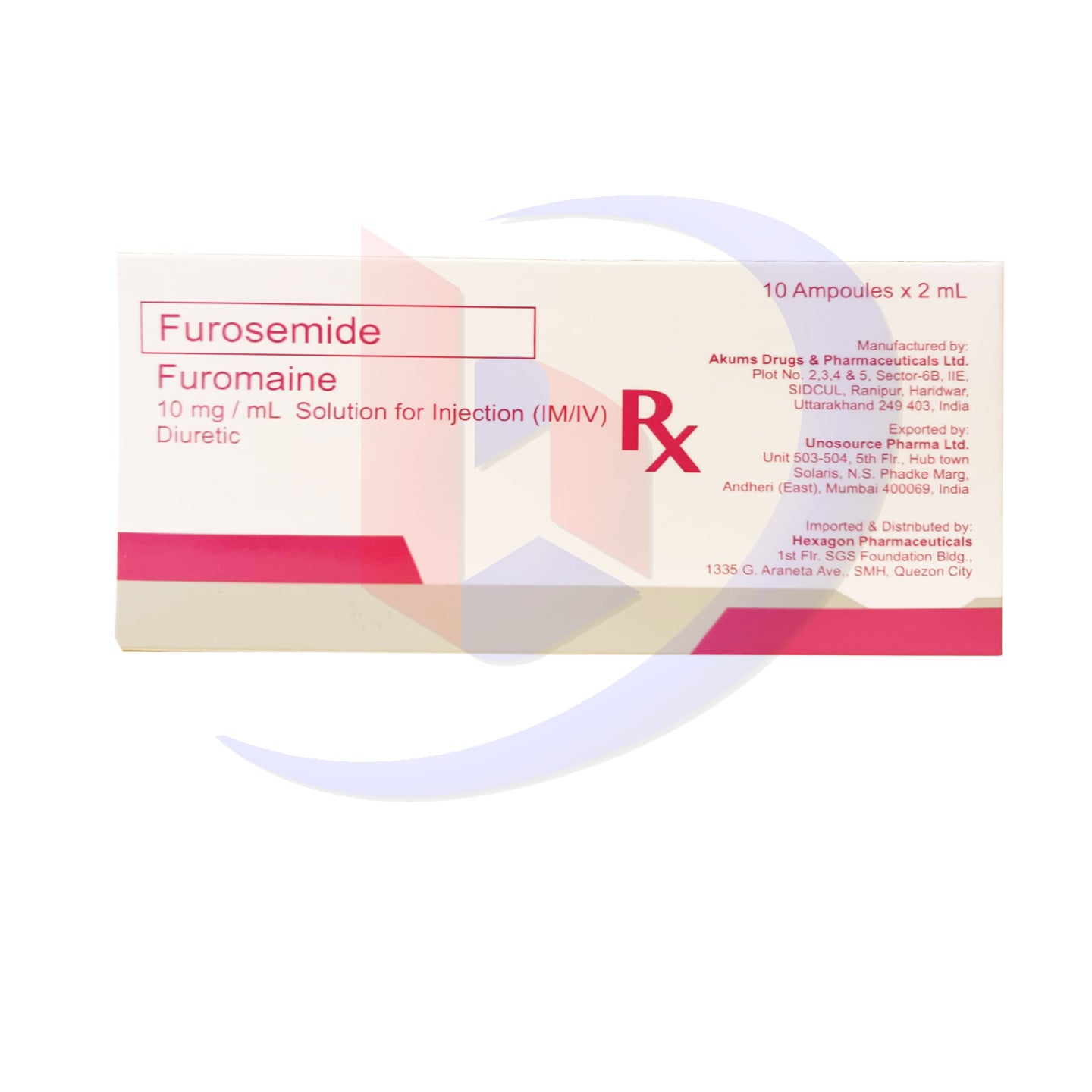Bambang Pharmaceutical Depot Inc.
Furosemide (Furomaine) 10mg/ml Solution for Injection IM.IV. Diuretic 2ml X Ampoules 10's
Furosemide (Furomaine) 10mg/ml Solution for Injection IM.IV. Diuretic 2ml X Ampoules 10's
Couldn't load pickup availability
Certainly! Below is the detailed information for Furosemide (Furomaine) 10mg/ml Solution for Injection (IM/IV) 2ml x 10 Ampoules:
Product Description:
Furosemide (Furomaine) is a loop diuretic commonly used to treat conditions involving fluid retention (edema) and high blood pressure (hypertension). The Furomaine 10mg/ml Solution for Injection is available in 2ml ampoules, and each ampoule contains 20mg of furosemide. It is typically sold in boxes containing 10 ampoules.
This injectable formulation provides a fast-acting solution, making it ideal for situations where quick diuresis (increased urine production) is needed, such as in acute pulmonary edema, severe edema, or when oral administration is not feasible or effective. Furosemide works by inhibiting the reabsorption of sodium and chloride in the loop of Henle in the kidneys, leading to an increased excretion of water, sodium, and chloride, and thus reducing fluid buildup.
Indications:
Furosemide (Furomaine) is indicated for:
-
Edema (Fluid Retention): Caused by conditions such as heart failure, cirrhosis of the liver, nephrotic syndrome, and chronic kidney disease.
-
Hypertension (High Blood Pressure): Furosemide is used to reduce blood pressure, often in combination with other antihypertensive medications.
-
Acute Pulmonary Edema: Furosemide is used in emergency situations to treat acute pulmonary edema, a condition where fluid accumulates in the lungs, causing severe breathing difficulties.
-
Chronic Kidney Disease (CKD): For managing fluid overload in patients with kidney dysfunction.
-
Hypercalcemia: It can be used in the treatment of high calcium levels (hypercalcemia), particularly in patients with cancer.
Dosage:
The appropriate dosage of Furosemide (Furomaine) varies depending on the condition being treated, the severity of the condition, and the patient's medical history. Below are general dosing guidelines:
For Edema (Fluid Retention):
-
Initial Dose: The usual starting dose is 20 to 40mg (2 to 4ml), injected intravenously or intramuscularly, as a single dose.
-
Titration: The dose can be increased every 2 hours by 20 to 40mg until the desired diuretic effect is achieved. In severe cases, the total daily dose may reach up to 600mg.
-
Maintenance Dose: After the desired effect is achieved, the maintenance dose is typically 20mg to 40mg given once or twice a day.
For Acute Pulmonary Edema:
-
Initial Dose: An IV bolus of 40mg (4ml) is usually given. If the response is inadequate, further doses may be administered every 1 to 2 hours as needed.
For Hypertension (Severe):
-
Furosemide may be used as part of a combination therapy for severe hypertension.
-
Initial Dose: Typically, 20 to 40mg intravenously is given, depending on the severity of the patient's hypertension.
For Hypercalcemia:
-
Initial Dose: Furosemide is typically administered at 20 to 40mg IV, with subsequent doses depending on the patient's calcium levels.
Important Note: When using Furosemide (Furomaine) injection, it is recommended to administer the injection slowly to minimize side effects such as hypotension (low blood pressure). The IV injection should be given over 1 to 2 minutes.
Side Effects:
Furosemide (Furomaine) may cause a variety of side effects. Common side effects include:
-
Electrolyte Imbalances: Including hypokalemia (low potassium), hyponatremia (low sodium), hypomagnesemia (low magnesium), and hypocalcemia (low calcium).
-
Dehydration: Excessive fluid loss can lead to dehydration, causing symptoms such as dry mouth, dizziness, and hypotension.
-
Hypotension (Low Blood Pressure): This can result in dizziness, fainting, or weakness.
-
Tinnitus (Ringing in the Ears) and Ototoxicity: High doses or rapid infusion rates may cause hearing problems or even permanent hearing loss.
-
Nausea, Vomiting, and Diarrhea: Gastrointestinal disturbances are possible.
-
Headache and Dizziness: These are common, especially when standing up quickly.
-
Rash or Allergic Reactions: Rashes, itching, or more serious allergic reactions such as anaphylaxis may occur.
Less common but more serious side effects include:
-
Kidney Dysfunction or Acute Renal Failure: Furosemide may exacerbate pre-existing kidney issues, potentially leading to kidney failure.
-
Pancreatitis: In rare cases, furosemide has been linked to inflammation of the pancreas.
-
Severe Allergic Reactions: Life-threatening reactions such as anaphylaxis, which may include swelling of the face, lips, tongue, or throat, requiring emergency medical treatment.
-
Severe Electrolyte Disturbances: Including dangerously low levels of potassium or sodium, which can lead to serious complications like arrhythmias or seizures.
If any serious side effects occur, it is important to seek immediate medical attention.
Contraindications:
Furosemide (Furomaine) should not be used in the following cases:
-
Hypersensitivity to Furosemide or Sulfonamides: If a patient is allergic to furosemide or any of its components, it should not be used.
-
Anuria (Inability to Produce Urine): Furosemide is contraindicated in patients with anuria, as it relies on the kidneys to promote urine production.
-
Severe Electrolyte Imbalances: In patients with significant deficiencies in potassium, sodium, or magnesium, furosemide should not be administered until these imbalances are corrected.
-
Severe Dehydration: Furosemide should not be used in cases of dehydration where it may further exacerbate fluid loss.
-
Hepatic Coma: It is contraindicated in patients with hepatic coma or severe liver failure due to potential worsening of hepatic function.
-
Pregnancy (Category C): Furosemide should only be used during pregnancy if the potential benefits justify the potential risks to the fetus. Always consult with a healthcare provider before using during pregnancy.
Precautions:
-
Renal Impairment: Furosemide should be used with caution in patients with kidney disease, as it can exacerbate renal failure or cause fluid and electrolyte imbalances.
-
Electrolyte Imbalance Monitoring: Close monitoring of serum potassium, sodium, and magnesium levels is necessary during treatment. Potassium supplementation may be required to prevent or treat hypokalemia.
-
Elderly Patients: Elderly individuals may be more sensitive to furosemide's effects, particularly with regard to electrolyte imbalances and hypotension. Dose adjustments and close monitoring are necessary.
-
Diabetic Patients: Furosemide may raise blood sugar levels, so careful monitoring of glucose is advised in diabetic patients.
-
Pregnancy and Breastfeeding: Furosemide should only be used during pregnancy when clearly needed, and it should be avoided in the first trimester if possible. It can pass into breast milk, so caution should be used when administering it to breastfeeding mothers.
-
Hypotension: Furosemide can cause a significant drop in blood pressure, particularly when administered rapidly. Careful titration and monitoring are needed, especially in patients with preexisting low blood pressure.
Drug Interactions:
-
Other Diuretics: Combining furosemide with other diuretics can increase the risk of electrolyte imbalances, dehydration, and hypotension.
-
Antihypertensive Medications: Furosemide may enhance the effects of blood pressure-lowering medications, leading to hypotension.
-
Lithium: Furosemide can increase the risk of lithium toxicity by causing sodium depletion.
-
NSAIDs (e.g., Ibuprofen, Aspirin): These can reduce the diuretic effect of furosemide and may increase the risk of kidney dysfunction.
-
Aminoglycoside Antibiotics (e.g., Gentamicin): Using furosemide with aminoglycosides increases the risk of ototoxicity (hearing damage).
-
Corticosteroids: When combined with furosemide, the risk of hypokalemia (low potassium) is increased, necessitating regular potassium monitoring.
Summary:
Furosemide (Furomaine) 10mg/ml Solution for Injection is a potent loop diuretic used to treat fluid retention (edema), hypertension, acute pulmonary edema, and hypercalcemia. The injectable formulation is designed for rapid action, particularly in emergency situations. It is available in 2ml ampoules, with each ampoule containing 20mg of furosemide.
Typical dosing ranges from 20mg to 40mg initially, with doses increased based on patient response. Common side effects include electrolyte imbalances, hypotension, and dehydration, while serious side effects can include kidney dysfunction, ototoxicity, and severe allergic reactions.
Furosemide (Furomaine) should be used cautiously in patients with renal impairment, electrolyte disturbances, and pregnancy. Close monitoring of electrolytes and kidney function is necessary during treatment.
Always follow the dosing instructions from your healthcare provider, and consult with them regarding any concerns or side effects during therapy.
Share

Product Features
Highlights
Details
Lot #
Expiry Date
"For All Your Pharma And Medical Supply Needs"
-
MEDICINES
We offer large range of generics and branded tablets, capsules, topicals, suppositories, drops or suspensions, inhalers and injections.
-
SUPPLEMENTS
High quality yet very affordable vitamins and minerals, specialty supplements, herbals and botanicals, sports nutrition, and weight management.
-
MEDICAL SUPPLIES
We serve all types of medical supplies needed in clinics, laboratories, and hospitals like cottons, gauze, alcohol, swabs, gloves, bandages, lancets, glucometer, etc.
-
MEDICAL EQUIPMENT
We also serve durable and affordable medical devices and equipment needed in clinics, laboratories and hospitals.
Subscribe to our emails
Be the first to know about new collections and exclusive offers of Bambang Pharmaceutical Depot Inc.


